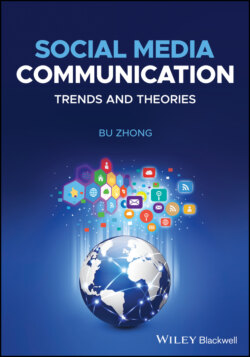Читать книгу Social Media Communication - Bu Zhong - Страница 14
Theory Highlight: Construal Level Theory
ОглавлениеConstrual level theory (CLT) is proposed to study how people can think about events that extend beyond the immediate context. It proposes that in order to look beyond here and now and understand distal objects, humans form varyingly abstract mental construals of them. These distal entities do not occur in present time, space, social realm, or actuality. While people cannot experience what is not present, they can rely on mental constructions such as prediction, memories, and speculation to transcend beyond the immediate situation and understand psychologically distant objects (Trope & Liberman, 2010). So there is a psychological distance between what people can feel here and now and the dimensions and measurements of “distance” of future events, remote places, distant others, and alternative realities. Here “psychological distance” can be a uniquely human ability, which is about the removal of an object or event from direct experience.
In other words, the theory holds that humans have the unique capacity to think about future events, remote places, distant others, and alternative realities. The CLT research shows that regardless of the psychological distance dimensions of an object, such as time, space, social distance, or hypotheticality, the mental construal processes are quite consistent, so as to be understood as cognitively related to each other (Maglio et al., 2013).
The basic premise of CLT is based on the link between distance and the level of mental construal. Objects viewed as more distant will be understood at a higher, more abstract level, which will then bring to mind more distant objects (Trope & Liberman, 2010). This notion of abstract versus concrete construal as it relates to distance is perhaps best understood through the proverbial distinction between the trees and the forest. When standing at a physical distance from a group of trees, one sees a forest in its entirety. When this distance is reduced, the large abstraction of a forest becomes individual trees. While this example focuses solely on spatial distance, the same logic can be applied to the other dimensions of psychological distance as well. For any dimension, Trope and Liberman (2010) explain that “as psychological distance increases, construals would become more abstract, and as level of abstraction increases, so too would the psychological distances people envisage” (p. 440).
Events can differ in terms of dimensions such as time, space, social distance, and hypotheticality as they happen. Human minds tend to treat these varying dimensions of distance in a mentally similar manner. For example, although time and space may be very different types of information, CLT suggests that people treat them interchangeably. Thus, from a psychological vantage point, just as an event one month from now is more distant than an event tomorrow, an event occurring to you is more distant than one occurring directly to me. As events become psychologically closer, information about detailed specifics becomes more available and reliable. CLT suggests that people incorporate this information by engaging in a low-level construal, representing events in terms of their more concrete and idiosyncratic features.
CLT is a widely applicable theory that allows researchers to examine the relationship between psychological distance from an object or entity and the corresponding level of thought, as either abstract or concrete. Scholars have applied CLT to varying domains in recent years through examining the distinction between abstractness and concreteness on individuals evaluations, predictions, and behaviors, including political attitudes (Alper, 2020). Studies examining CLT and political attitudes are broad in scope and have measured how CLT’s psychological distance influences: political polarization, ideological differences, moral values, and political sophistication. Beyond political analysis, CLT has been applied to research studying new mobile and social technological use (Tseng & Hsieh, 2019; Young, 2015).
